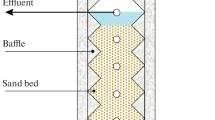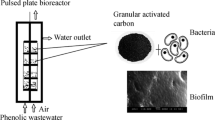Abstract
Biofilm reactors are particularly suitable for the treatment of large amounts of diluted effluent, such as groundwater contaminated with scarcely soluble pollutants. A packed-bed column reactor was tested for the degradation of acenaphthene, phenanthrene and pyrene provided at their aqueous solubility concentrations. Acenapthene and phenanthrene were removed to more than 99% efficiency from this reactor whilst pyrene was removed to 90%. Pollutant disappearance was also recorded in the control reactor and was probably caused by the adsorption of pollutants into the reactor. The measurement of oxygen consumption in both reactors confirmed that microbial degradation of the pollutants was indeed occurring in the inoculated reactor. Physical adsorption is not however unwanted, as it could help with the formation of a biofilm at an early stage of the treatment.
Similar content being viewed by others
Author information
Authors and Affiliations
Additional information
Received: 29 February 2000 / Received revision: 30 May 2000 / Accepted: 3 June 2000
Rights and permissions
About this article
Cite this article
Guieysse, B., Bernhoft, I., Andersson, B. et al. Degradation of acenaphthene, phenanthrene and pyrene in a packed-bed biofilm reactor. Appl Microbiol Biotechnol 54, 826–831 (2000). https://doi.org/10.1007/s002530000442
Issue Date:
DOI: https://doi.org/10.1007/s002530000442




